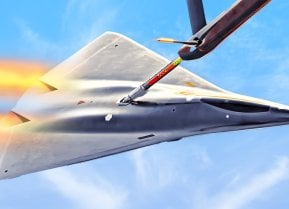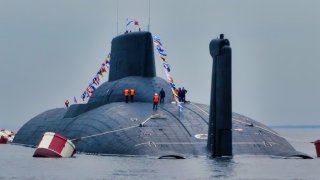Typhoon-Class: Russia Built the Biggest Submarine Ever (48,000 Tons)
The Dmitry Donskoy (TK-208), the world's largest nuclear-powered submarine and the last of the Russian Navy's Typhoon-class, was decommissioned in February 2023 after nearly 40 years in service.
Summary and Key Points You Need to Know on the Biggest Submarine Ever: The Dmitry Donskoy (TK-208), the world's largest nuclear-powered submarine and the last of the Russian Navy's Typhoon-class, was decommissioned in February 2023 after nearly 40 years in service.
-Originally laid down in 1976 and commissioned in 1984, the submarine was a formidable force during the Cold War, capable of carrying 20 RSM-52 SLBMs with multiple warheads.
-Despite previous plans to keep the vessel in service until 2026, it was retired and will await disposal.
-The decommissioning marks the end of the era for the Typhoon-class, the largest submarines ever built.
Farewell to the Typhoon-Class: Dmitry Donskoy Submarine Decommissioned
The world's largest nuclear-powered submarine, Dmitry Donskoy (TK-208) has been decommissioned, the Kremlin announced back in February of last year.
The Russian Navy's Project 941 Akula-class (NATO reporting name Typhoon) heavy nuclear ballistic submarine was laid down in June 1976 and commissioned in 1984. After almost 40 years in service, she has finally been retired.
"The Dmitry Donskoy submarine cruiser has been decommissioned from the Russian Navy. It will await utilization at a naval base in Severodvinsk together with two other units of this project," Vladimir Maltsev, the head of the Russian Movement for Navy Support, told the Russian state media outlet Tass.
Initially designated the TK-208, she was the lead vessel of the Soviet third-generation Akula-class (Russian for "Shark"), and after a 12-year overhaul and refit that began in 1990, she reentered service in 2002 as the Dmitry Donskoy, named after the Grand Duke of Moscow Dmitry Donskoy (1359–1389), the reputed founder of Moscow.
It is worth repeating the boat is more commonly known as the Typhoon-class or by its NATO designation.
This is a change of course for Moscow, which had previously stated that the submarine would remain in service until at least 2026.
Typhoon-Class: Project 941 Boats
The Sevmash Shipyard built six of a planned seven Project 941 submarines - or what the West calls the Typhoon-class - for the Russian Navy, and all of the boats were operational with the Northern Fleet. Though the oldest of the submarines, Dmitriy Donskoy was the last of the class to remain in service.
The TK-202, TK-12 – later renamed the Simbirsk – and T-13 were withdrawn from active service between 1996 and 2009, and scrapped with the financial support of the United States. Two other boats: the TK-17/Arkhangelsk and TK-20/Severstal remained in service until they were decommissioned circa 2013.
A seventh boat, TK-210, was laid down but scrapped before completion.
Typhoon: Large and Powerful
With a displacement of 48,000 tons, a length of 175 meters (nearly 600 feet), a 23-meter beam, and a 12-meter draught, the Typhoon-class were the largest submarines ever built.
Developed with multiple pressure hulls, including five inner hulls situated inside a superstructure of two parallel main hulls, the Typhoon-class was also wider than any other submarine ever built.
Each contained nineteen compartments, including a strengthened module, which housed the main control room as well as an electronic equipment compartment above the main hulls and behind the missile launch tubes. It even was reported that there was a sauna on board as well as a small swimming pool for the crew. The sheer size of the submarines was likely welcomed by the approximately 160 sailors who called the submarine home on voyages lasting 120 days or longer, oftentimes without surfacing for months at a time.
The Typhoon-class subs were designed to counter the United States Navy's Ohio-class subs, which were capable of carrying up to 192 100-kiloton nuclear warheads. By contrast, the Soviet Typhoons could carry a primary cache of 20 RSM-52 SLBMs (submarine-launched ballistic missiles), each of which contained up to 10 MIRV (multiple independently targetable reentry vehicle) warheads.
The submarines were powered by OK-650 pressurized-water nuclear reactors, two 50,000 horsepower steam turbines, and four 3,200 KW turbogenerators and this provides the boat with the ability to sail at a speed of up to 22.2 knots on the surface and 27 knots whilst submerged.
The boats of the Typhoon-class could reportedly operate at depths as great as 400 meters and travel at speeds in excess of 27 knots. The class was designed with an advanced stern fin with a horizontal hydroplane fitted after the boat’s screws, while the nose horizontal hydroplanes in the bow section were designed to be retractable into the hull.
The retirement of Dmitry Donskoy ends the saga of the largest submarines ever built. RIP, Typhoon-class.
Author Experience and Expertise
Peter Suciu is a Michigan-based writer. He has contributed to more than four dozen magazines, newspapers, and websites with over 3,200 published pieces over a twenty-year career in journalism. He regularly writes about military hardware, firearms history, cybersecurity, politics, and international affairs. Peter is also a Contributing Writer for Forbes and Clearance Jobs. You can follow him on Twitter: @PeterSuciu.
All Images are Creative Commons.


